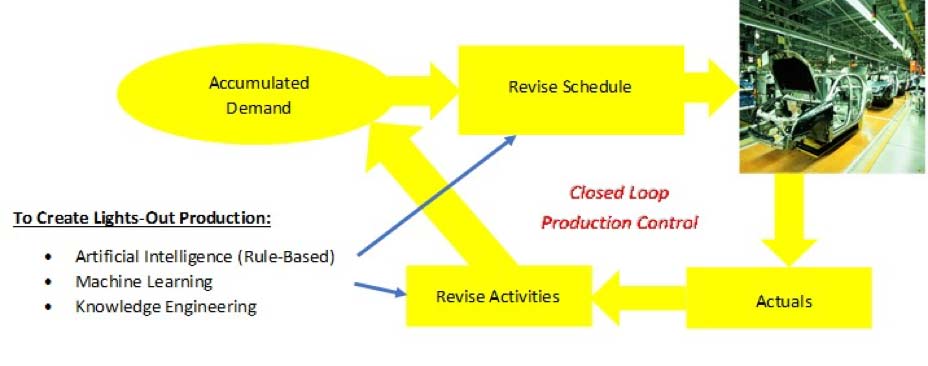Closing the Loop on MES and Lights-Out Production
A White Paper
© 2022 Unique Scheduling Solutions, LLC.
September 2022
Recently, the Gartner Group published a white paper entitled “Lights-Out Production will be a Reality by 2025.“ They describe the concept of lights-Out manufacturing as “equipping shop floor equipment with sensors and monitoring devices that communicate with analytic and predictive automation software –” This suggests that producers of enterprise support applications (ERP) must take a serious look at the requirements for automating the changes necessitated by off-plan deviations detected by shop floor data collection. In a blog, R. Landman has identified six major circumstances that necessitate plan revision. They include machine breakage or error, violations of quality standards, personnel absenteeism, new priorities, and other issues.
The recent trends toward digitization, robotics, and near-real-time data collection have focused primarily on the presentation of the current ‘state’ of the shop floor to production managers. While this is an essential element of a Manufacturing Execution System (MES), it does little to assist the production managers in determining the best corrective actions. Lights-Out Production suggests that the corrective action will also soon be automated. That is, the whole production environment will be a closed-loop control system in which ‘errors’ are fed back into a replanning process which results in a revised plan being sent to the shop floor for execution. The required design for Lights-Out Production must be from the perspective of feedback control. It’s not enough to know what went wrong; it’s equally important to know what to do to correct the deviation with minimal negative impacts.
There is an additional complexity in achieving a Lights-Out Production System. While deviations from a plan are being detected, new production requirements are also being received. That is, new orders are arriving, new priorities are being established, or standard procedures are being revised. These new requirements must be blended with the corrective actions made necessary by shop floor deviations from the current plan. When issued to the shop floor, a new plan must contain a combination of new production requirements and the corrective actions caused by the real-world deviations from the last plan.
Here are typical questions that must be answered by a Lights-Out Production System.
- How should scheduled activities be revised to complete the planned production?
- Which activities on an existing plan are affected by a detected machine outage or production shortfall?
- What should be done when a combination of resources and materials become unavailable?
- If the plan is altered in some specific way, what are the consequences?
- What happens if production managers try to optimize to a different set of KPI’s (Key Performance Indicators)?
- What is the minimum disruptive change that will correct the off-plan situation?
It is apparent from the Gartner Group and others that a software system that supports a production manager’s answers to these questions must be designed and implemented from the perspective of changing a plan rather than generating a new plan from scratch. Many existing scheduling applications are schedule generation systems, not schedule revision systems. They will not fit well within the Lights-Out Production concept discussed above because they will respond to problems by eliminating the current plan and replacing it completely. This can create chaos on the shop floor due to frequent changes that have no similarity to any previous version. From the perspective of a feedback control system, this is a non-convergent control system.
For some time, analysts have studied how human production managers step through the schedule revision process. Deriving from these efforts, we can begin to automate these processes. Artificial Intelligence (AI) and Machine Learning can begin to replace their tasks. Care must be taken, however, because managers respond to problems in a variety of ways across different organizations and disciplines. AI architectures (Rule-Based) must be employed because hard coding of change procedures can produce non-intuitive results which result in:
- greater effort to ‘trick’ the system into behaving as desired, or
- abandoning the system altogether
The figure below illustrates where AI can be inserted to evolve from an MES system with a human in the feedback loop to a ‘Lights-Out’ system envisioned in the Gartner paper.

Here are a few requirements for a re-planning system that have resulted from a serious human factors analysis focused on replanning activities:
- Find and unschedule all production activities that satisfy …. (Boolean statement of some ‘and’, ‘or’, and ‘not’ conditions).
- Revise one or more production activities to complete an unfinished activity or order.
- Schedule selected activities into ‘holes’ (time intervals) resulting from removing some activities.
- Adjust the scheduling criteria easily. Sometimes temporarily.
- Be sure that constraint satisfaction is assured during all schedule changes.
- Find all possible rescheduling possibilities without trial and error.
- Facilitate what-if Planning.
- Schedule backward, Forward, Either, or without time sequencing.
- See the consequences of constraints that are temporarily ignored.
- Isolate decision-making criteria from data processing and allow easy adjustment to (AI) rules.
- Maximize domain independence. Shop floor environment must be data-driven with easy editing.
- Structure Software so that decision logic (future AI) is separated from data processing.
- Accommodate priority changes easily.
- Track the change history; who made them; when they occurred; the result of the change.
Finally, note that schedule generation is a special case of schedule revision. If you can change an existing schedule, – one for which a timeline exists-, you can certainly create a schedule from a blank timeline.
Schedule change applications already exist that satisfy the requirements above and more. They are the right ones to insert into the feedback loop when data is collected from the shop floor. They “close the Loop” to create an effective MES, and they will produce the knowledge engineering necessary for incrementally automating the change logic, thereby creating Lights-Out Production.
© 2022 Unique Scheduling Solutions, LLC.
